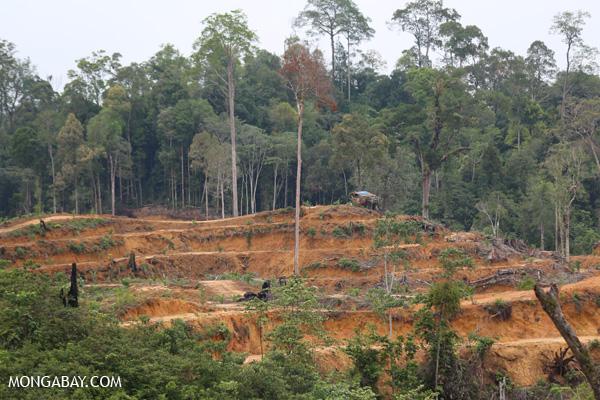Marivic Bero, secretary-general of the Coalition Against Land Grabbing (CALG) said in a statement during the Yangon Workshop on Human Rights and Agribusiness in Myanmar, that “our hope is that, through the Special Rapporteur, the complains [sic] of our Palawan farmers and IP [indigenous people] brothers will be brought directly to the higher levels of our national government, as well as to selected agribusiness corporations.”
CALG gathered at least 4,000 signatures from tribes-people and farmers affected by the plantations, calling for a moratorium on oil palm expansion.
According to a Survival International report released in October, there are plans to convert up to 20,000 hectares of land in an area that includes forests and indigenous communities to oil palm plantations.
Palm oil is primarily used as a cooking oil, in food products, and for cosmetics and detergents. It is also being increasingly used for biofuel production.
The current UN Special Rapporteur is Victoria Tauli Corpuz, a well-known indigenous people’s rights advocate from the Philippines. In an earlier report, she said, “[These issues exist because] many governments just opted to give away our natural resources to big corporations…even if it means the rights of people who have been saving these resources and using them sustainably are violated, so I think that’s the challenge we face now.”
Palawan, often called “the Philippines’ last frontier,” is a narrow island located West of the Philippine archipelago. It hosts two World Heritage Sites and a wide array of endemic wildlife. But it lost more than 6 percent of its forest cover between 2001 and 2012, according to Global Forest Watch.
The Philippines is not yet a major producer of palm oil, dwarfed by its neighbors, Malaysia and Indonesia which have more than 15 million hectares between them and account for more than 85 percent of global production. But the country has ambitions to become a significant player. According to the Philippine Coconut Authority’s (PCA) 2014-2023 roadmap for oil palm, the Philippine government is seeking to develop at least 56,641 hectares of land for oil palm plantations, with another one million hectares earmarked for plantation expansion by 2023. The PCA stated that in the next 10 years, demand for palm oil is set to increase 5 percent per year.
Palm oil cultivation is a big driver of deforestation, contributing to the loss of some 3.5 million hectares of forest in Malaysia, Indonesia, and Papua New Guinea in 20 years alone.
In response to Paje’s announcement of the plan to develop eight million hectares of land for oil palm plantations, Daniel Webber of the Roundtable on Sustainable Palm Oil (RSPO) said in a business forum that social and environmental impact studies are needed to ensure community wellbeing and mitigate environmental damage.
The Sweden-based Stockholm Environment Institute (SEI) released a working paper earlier this year, showing the extent and implication of the growing palm oil industry in Palawan. According to the paper palm oil concessions occupy up to 99 percent of the total amount of agricultural land in southern part of the province.
A conservative estimate from the Department of Agriculture states the amount of land cultivated for oil palm in Palawan province grew from 3,500 hectares in 2009 to 5,840 hectares in 2013. However, research presented August 2014 to the Malaysian Palm Oil Council by Dr. Pablito Pamplona, an agricultural researcher affiliated with the Provincial Oil Palm Development Council, indicates 6,240 hectares of oil palm had been established as of April 2013. Meanwhile, reports from the Provincial Planning and Development Office and the Provincial Agriculturist Office references licenses for oil palm development projects in Palawan cover a total of 15,469 hectares, representing 2 percent of the total land area of the province, according to the SEI paper. Furthermore, the PCA and Palawan Palm Oil Industry Development Council (PPOIDC) have identified 208,000 hectares as suitable for oil palm cultivation.
However, a representative from one of the two companies overseeing palm oil expansion in Palawan maintains not all land covered by licenses will be developed, and that the presence of the palm oil industry will be beneficial to local communities. This is discussed in more detail in the second part of the series.
Citations:
- Hansen, M. C., P. V. Potapov, R. Moore, M. Hancher, S. A. Turubanova, A. Tyukavina, D. Thau, S. V. Stehman, S. J. Goetz, T. R. Loveland, A. Kommareddy, A. Egorov, L. Chini, C. O. Justice, and J. R. G. Townshend. 2013. “Hansen/UMD/Google/USGS/NASA Tree Cover Loss and Gain Area.” University of Maryland, Google, USGS, and NASA. Accessed through Global Forest Watch on Dec. 21, 2014. www.globalforestwatch.org.






